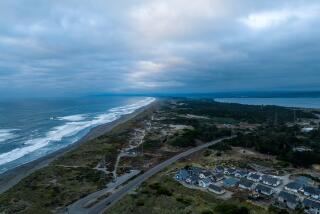Picture of a Small Town : Redlands’ vintage homes, charm and quiet streets make it a nice place to live and a picturesque backdrop for filmmakers.
- Share via
When Universal Pictures location scout Murray Miller was looking for a place with old-fashioned ambience to film the movie “How to Make an American Quilt,” he chose the San Bernardino County city of Redlands.
After driving slowly up and down Grant Street for a couple of days studying houses, Miller had a hard time convincing resident Eva Templeton that he wasn’t casing her 1887 Victorian cottage.
“He said he thought Redlands was the perfect place to film this movie, and I thought ‘Oh, sure,’ ” Templeton said.
Miller eventually persuaded her to allow the residence (originally the home of Redlands’ first constable) to be used in the film about a sewing circle. The movie was released last year, and Templeton’s relatives and friends have called to say they recognized her house posing as the home of character Constance.
Redlands, a city of 60,000 people about 60 miles east of Los Angeles, is known for its vintage homes and small-town charm. Despite a rich repertoire of cultural activities, the city is so quiet that local teens often refer to it as “Deadlands.”
But their parents are happy to live in a place that’s still “a safe place to jog and walk your dog,” said Tricia Sandlin, general manager of Century 21 Sevel and Associates real estate brokerage.
Residents defeated a growth control initiative in November, signaling a shift in attitude toward encouraging more commercial activity in a city primarily known as a bedroom community. Two previous growth control initiatives were approved by voters.
“We have to grow and develop,” said Joyce Dangermond, who was born in Redlands and farms citrus acreage that has been in her family since the 1930s. “You can’t keep anything the way it was.”
Dangermond, who also runs a nursery with her husband, Allen, remembers when Redlands had so many orange groves that cold weather meant the city was covered by a thick pall of black smoke from the ubiquitous smudge pots used to keep the fruit from freezing. Now there is less smoke but more smog, because of fewer orange groves and many more people. Temperatures in Redlands don’t drop below freezing very often, although it tends to have cooler nights and warmer days than Los Angeles.
Founded in the 1880s as a citrus-growing community, Redlands (named for the color of the local soil but pronounced Redlunds) attracted many wealthy individuals from the East and Midwest seeking winter homes in sunny Southern California.
Citrus was the primary industry for the first 50 years, said Frank E. Moore, who was editor and co-owner of the Redlands Daily Facts newspaper for four decades. Moore, who has written several books about the city, said other major influences were the establishment of nearby Norton Air Force Base, which attracted scientific and engineering professionals to the area, and the construction of Interstate 10 through town, which made it easier for residents to commute elsewhere to work.
Norton was recently closed as a cost-cutting measure, and attempts are being made to convert it to commercial use.
Today, Redlands is still a favorite abode for professionals in western San Bernardino and Riverside counties, Sandlin said. “We get a tremendous number of doctors from Loma Linda,” she said, referring to the neighboring city that is home to Loma Linda University Medical Center, a veteran’s hospital and other medical facilities.
Typically, Redlands has been a move-up market for San Bernardino County buyers. But slowing home sales of the last few years mean many potential purchasers can’t sell their existing homes, so first-time buyers now represent a larger share of home shoppers. Homes priced at $100,000 are selling, as are very expensive houses, but dwellings in the $200,000 range are staying on the market longer and owners are reducing prices, Sandlin said.
Existing houses range from 1920s California bungalows and Victorian edifices with cupolas, porches and portes-cocheres to ranch homes built in recent decades. A typical Redlands resale home has three bedrooms and two baths in 1,500 square feet and sells for about $150,000, she said.
A few custom homes are built each year in the city, said Jeff Shaw, community development director, but most builders are waiting until demand for new homes increases.
Redlands has about 4,000 homes that are more than 50 years old, said Christie Hammond, associate archivist at the city’s A.K. Smiley Memorial Library.
The Moorish-style library, built in 1898 and donated to the city by philanthropist Albert Smiley, is itself a California historic landmark. Gargoyles, griffins and other oak carvings decorate its interior, along with stained-glass windows and tile fireplaces.
“American Quilt” wasn’t the first time Redlands’ historic houses have had starring roles on screen. One of the city’s most famous mansions, Kimberly Crest, has been featured in movies, music videos and commercials. The 1897 house, once the winter residence of members of Wisconsin’s Kimberly family, whose fortune was built on the paper products of Kimberly-Clark, is now a popular spot for tours, and its Italian renaissance garden is in demand for weddings.
The 1890 Morey Mansion, noted for its Saracenic dome and French mansard tower, is a bed-and-breakfast. The Edwards Mansion is used for weddings and parties. The 28-room Burrage Mansion, built in 1901 and still a private home, recently sold for $2.4 million, Sandlin said.
Commercial projects in various stages of development include the Citrus Plaza shopping center, Pharaoh’s Lost Kingdom amusement park and a 14-theater complex, Shaw said.
Citrus Plaza could become a large employer if developer Majestic Realty is able to expand it to a regional mall, as planned.
One person not entirely happy with the prospect of a new shopping center and more development citywide is Mike Haverty, one of the organizers of the failed growth control initiative.
“We’re not trying to stop growth,” said Haverty, whose forebears once owned the Redlands Livery Stable. “We’re trying to control it and make it responsible.”
The expense of providing additional services won’t be adequately covered by development fees, Haverty said, thus raising costs or cutting services to current residents. The new shopping center will siphon sales from existing businesses downtown, he added.
But Katherine Thomerson, owner of the Frugal Frigate bookstore in downtown Redlands, said growth can be controlled by working with the city, rather than by a strict ordinance.
She acknowledges that chain-owned mall bookstores provide tough competition but said small stores can offer special events and extra services to cultivate customers. “I have a wonderful following from the community,” Thomerson said. “I can’t think of any better place to open a bookstore” than Redlands, which has several independent bookshops.
Coffeehouse operator Sue Daniels said that although it was a bit of a challenge to get needed city approvals for her business, residents have responded favorably to her blend of coffee, food and entertainment.
Daniels, co-owner with Marianne Dorado of Jazz and Java, near the old Santa Fe Depot, said the planned movie theaters could boost her sales by bringing more people downtown at night.
One occasion that does lure Redlands residents downtown is Thursday’s Market Night, an open-air event featuring organically grown produce, crafts, food and entertainment.
Redlands prides itself on its appreciation of the arts, and former newspaper editor Moore attributes this tradition to the Smiley brothers. Library donor Albert Smiley and his identical twin, Alfred, helped give the city its soul, Moore said. The Smiley brothers, including younger sibling Daniel, gave generously to civic causes.
The private University of Redlands, which has 1,500 undergraduates on its campus and 2,500 adult students at five regional centers, also provides many cultural opportunities, including musical and literary events, Moore said.
Kay and Ed Holzrichter enjoy being able to walk to musical performances in Prospect Park from their 1891 Victorian. The house has 5,000 square feet of living space, with five fireplaces and a wraparound porch. It was a boardinghouse before the Holzrichters moved in 15 years ago.
“My husband and I have traveled all over the world, and we’ve lived lots of places,” Kay Holzrichter said. “Redlands is the best.”
The city’s many historic sites and homes hold a special appeal for bookseller Thomerson, who enjoys walking by picturesque streets, including Normandie Court, with its 1920s “Hansel and Gretel” cottages.
Her own neighborhood of 1950s houses, known as “La-La Land” because all the street names begin with “La,” offers an assortment of home styles.
“I love living here,” Thomerson said. “It’s such a nice community.”
Son Brad, 22, used to think Redlands didn’t offer enough to do. But recently, on a visit from college, he told Thomerson: “I really think if I got married, I wouldn’t mind coming back and raising kids here.”
(BEGIN TEXT OF INFOBOX / INFOGRAPHIC)
At a Glance
Population
1995 estimate: 58,024
1990-95 change: -3.9%
Annual income
Per capita: 19,940
Median household: 37,806
Household distribution
Less than $30,000: 38.6%
$30,000 - $60,000: 33.4%
$60,000 - $100,000: 19.1%
$100,000 - $150,000: 5.7%
$150,000 + : 2.6%
More to Read
Only good movies
Get the Indie Focus newsletter, Mark Olsen's weekly guide to the world of cinema.
You may occasionally receive promotional content from the Los Angeles Times.










